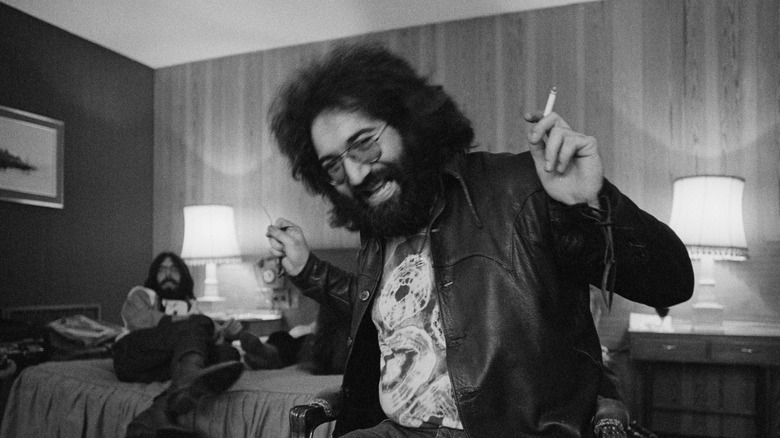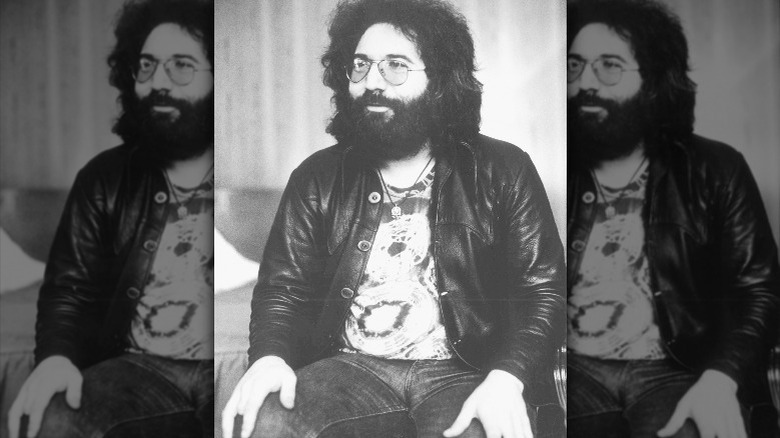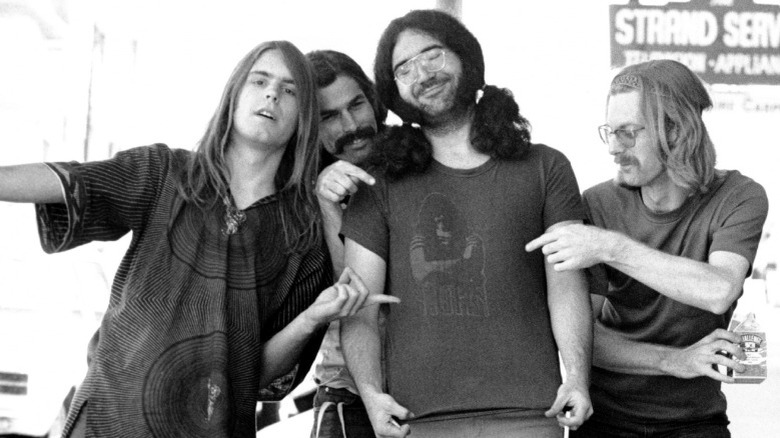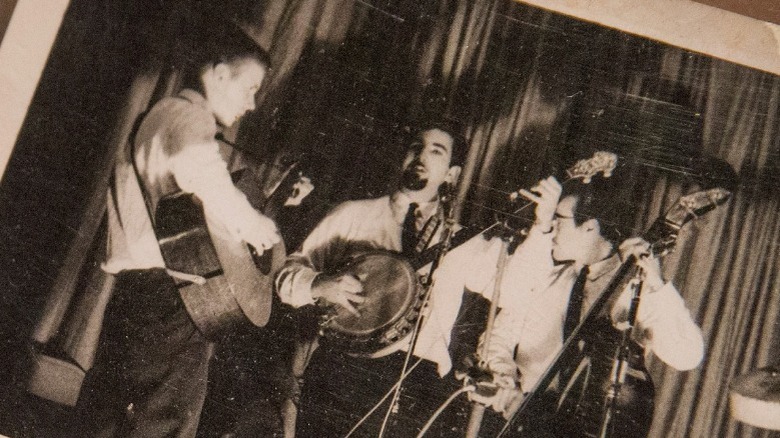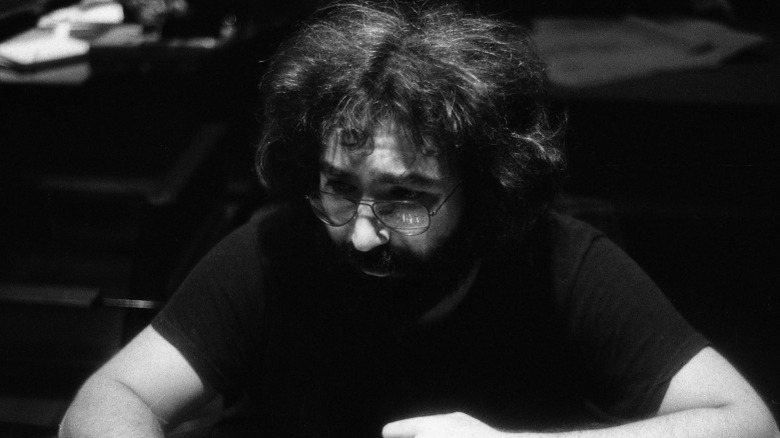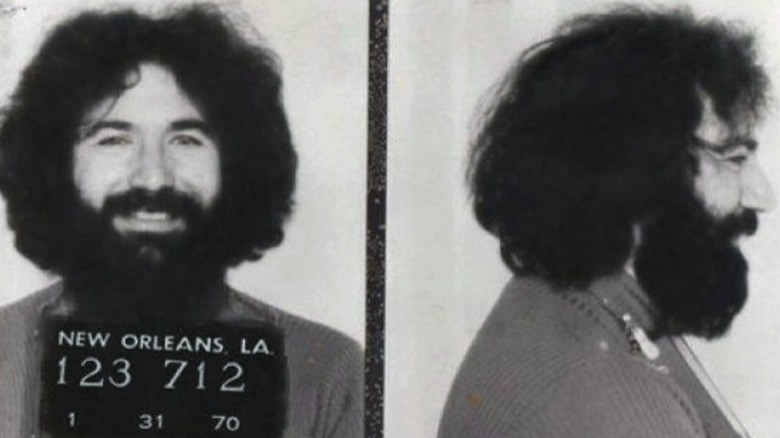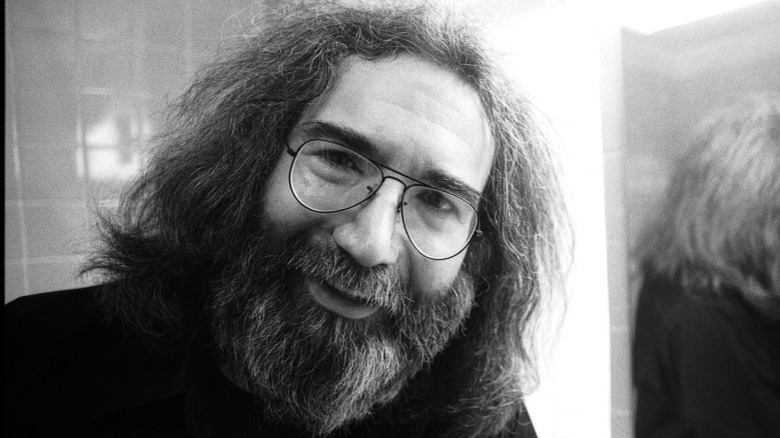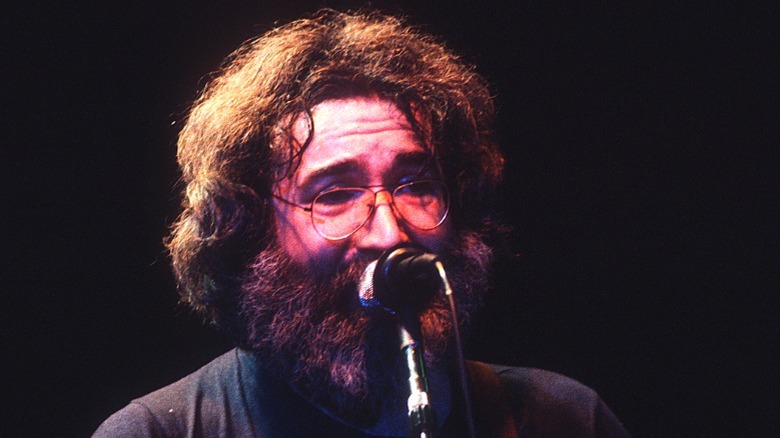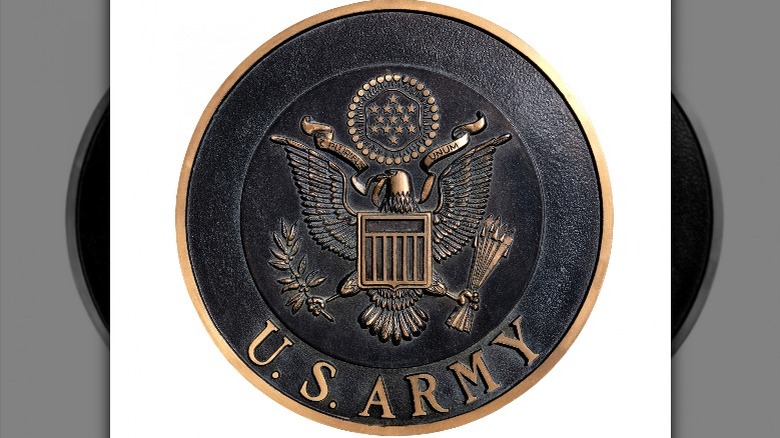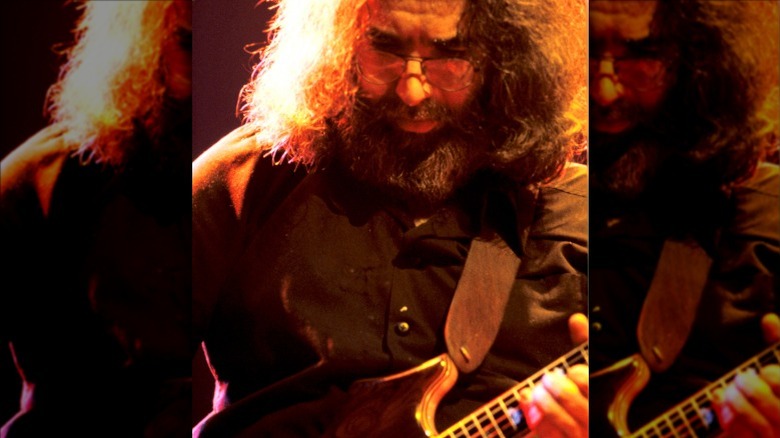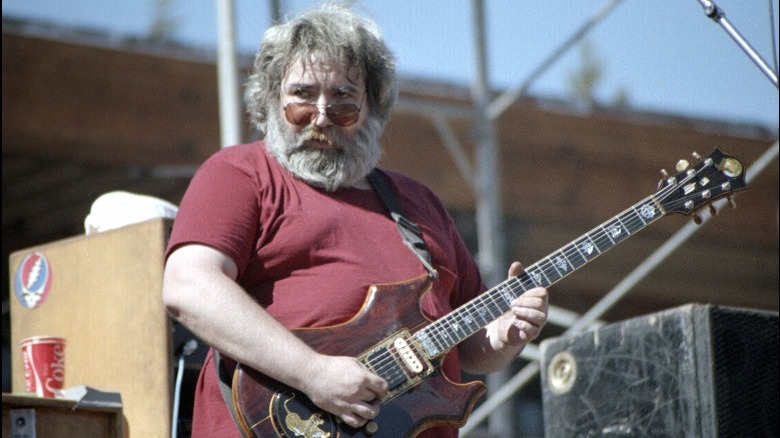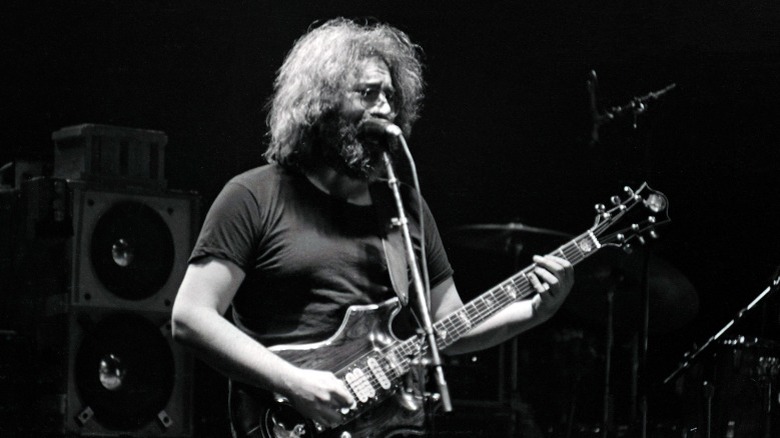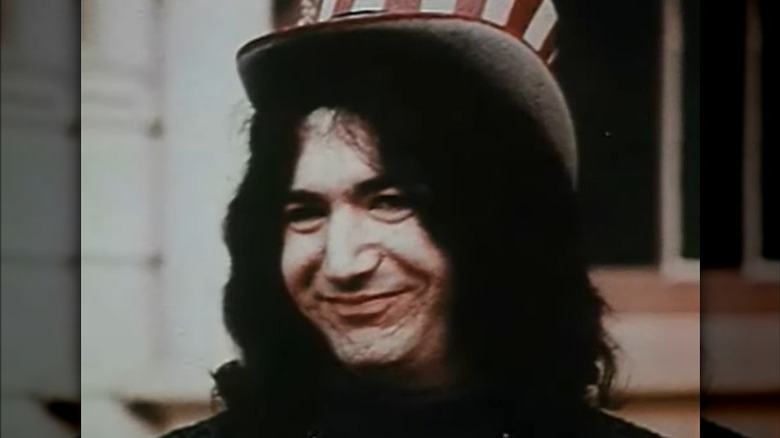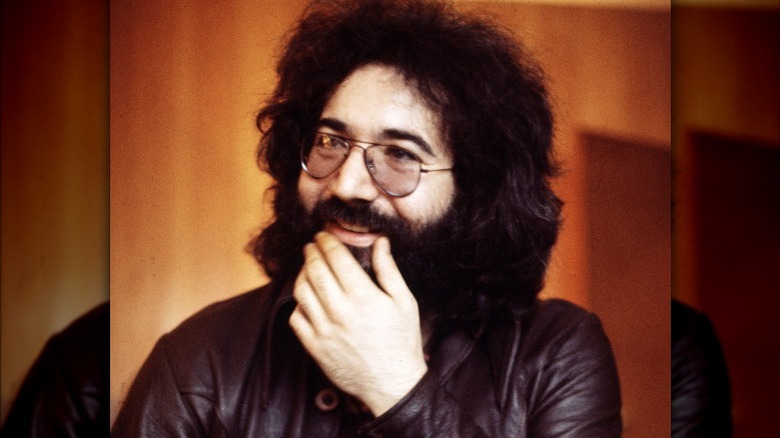The Untold Truth Of Jerry Garcia
In August 1995, the world lost a psychedelic musical giant when Jerry Garcia passed in his sleep at the Serenity Knolls treatment center in California. Born in San Francisco during WWII, Garcia grew up in various parts of northern California, excelling at both art and guitar (per Allmusic.com). He and his friends formed the Grateful Dead in 1965, and they immediately took the psychedelic scene by storm. They performed at Woodstock and became one of the defining bands of 1960s counterculture. The band itself is legendary for its devoted cadre of fans, known colloquially as Deadheads, and Garcia found himself center stage for all the attention as the singer, main lyricist, and lead guitarist in the band.
Today, he is remembered for his incredible musical contributions to rock and roll and is one of the most recognized American recording artists of the 20th century. He died at the age of just 53, a stifling end to one of the brightest flames in Americana lore. Though he was one of the most charismatic performers in rock history, his personal life was plagued by drug addiction and the constant deaths of his close friends. This is the untold truth of Jerry Garcia.
His brother chopped part of his finger off
One of the most iconic Grateful Dead images is the four fingered handprint of Garcia's right hand. The middle finger is notably shorter than the others, and it's common knowledge among Deadheads that this is because Garcia lost part of this finger when he was young. Yet, what most fans do not know is exactly how he lost his finger.
According to Blair Jackson in "Garcia: An American Life," Garcia and his older brother Clifford, known as "Tiff," were vacationing at their summer home in Lompico, California, and chopping wood together for their fire pit. They had gotten into a rhythm, Tiff swinging the ax while Jerry cleared away the split wood, but at one point they got out of sync and the ax came down on Garcia's ring finger, nearly severing it just above the second knuckle. His mother quickly wrapped his finger in a towel before they rushed to the hospital, where the top-half of his finger was amputated. Garcia, a four-year-old at the time, did not realize that his finger had been amputated, he just thought it was heavily bandaged. When he took off his bandages weeks later and realized half of his finger was missing, he was shocked.
He was an accomplished artist and had a fashion empire
While Jerry Garcia is primarily known for his contributions to the music world, he was also a successful artist by the late 1980s, and he had created the beginnings of a fashion empire. An LA Times article published just months before his death in 1995 detailed the heights his empire had already reached by then. His artwork had been transposed onto a number of different mediums, including ties and wetsuits, and even more zany ideas came, too. The Beverly Prescott Hotel in Los Angeles spent $18,000 creating a room themed around his artwork, and they charged guests an extra $50 per night to stay in it. The article noted plans for the future were only increasing, with his clothing line to be extended to include women's wear, formal wear, items made of silk fabrics, and more water-wear items.
Garcia's art career spanned his entire life. He attended the San Francisco Art Institute when he was young and created over 2,000 pieces of art throughout his career (per Rolling Stone). Though he was successful during his life, since his death, his paintings and other works have reached incredible new heights. In 1995, the LA Times estimated his lithographs sold for $250-$600, but today they routinely price in the multiple thousands of dollars at brokerages. In a sign of the times, in 2021 his work was offered for the first time in the form of non-fungible tokens, or NFTs.
He played banjo in several bluegrass and folk bands
Fans familiar with the overweight, heavily bearded, sunglasses-wearing image of Jerry Garcia might be shocked to see how he looked in the early '60s as a bluegrass player and folkie (pictured above, middle, 1962). According to his first wife, Sara Ruppenthal Garcia, they first met when Garcia was playing as a banjoist in a local bluegrass band (via "Dark Star"). She immediately joined the band and the two of them started singing together almost instantly. Eventually, Garcia got a gig playing at the College of San Mateo Folk Music Festival with a new bluegrass group, and guitar player John "Marmaduke" Dawson considered him the best banjo player in the area (via "Dark Star").
In Dennis McNally's book, "A Long Strange Trip: The Inside History of the Grateful Dead," he details the myriad of different bluegrass and folk bands Garcia played with. Some of their names included the Sleepy Hollow Hog Stompers and the Hart Valley Drifters. They played mainly covers of popular folk singers, like Joan Baez and the Kingston Trio, along with traditional songs like "Deep Ellum Blues" and "Man of Constant Sorrow." Incidentally, according to McNally, during his folk years, Garcia took his younger bandmates under his wing in order to teach them the finer aspects of smoking pot.
His close friend died in a car crash when he was just 19
In one of the most tragic and heart wrenching moments of Jerry Garcia's life, he lost his close friend Paul Speegle when he was just 19 years old. In late February 1961, Garcia, Speegle, and a couple of friends were driving around East Palo Alto trying to score some marijuana (per "A Long Strange Trip"). The car was being driven by the manager of their rooming house, a man named Lee Adams, who had a penchant for speed. At one point, Adams got the car up to nearly 100 mph before crashing into a sharp turn near the Menlo Park Veterans Hospital. The car rolled and all the passengers were ejected, except Speegle, who died in the wreck. Garcia was himself thrown through the windshield and suffered a broken collarbone and likely a concussion, as he was unable to remember the events of what had happened.
In the book, "Captain Trips: A Biography of Jerry Garcia," Sandy Troy writes that the accident had a profound effect on the rest of Garcia's life. He had switched places with Speegle just moments before the crash had happened, and he constantly talked about the traumatic event in the months afterwards. The crash fueled Garcia to focus his life on music, and he immediately started playing folk music with his friends Robert Hunter and Marshall Leicester.
He got the nickname 'Captain Trips' because he dropped so much LSD
As detailed in "A Long Strange Trip," the Grateful Dead were all avid consumers of the drug LSD, and none more-so than Jerry Garcia. The Dead used to play at a series of parties known as the "Acid Tests" that were hosted by the counterculture group known as the Merry Pranksters. Per McNally, they used to spike Kool-Aid with LSD at the parties and play music to the stoned crowd. It was during one of these parties that Prankster Denise Kaufman gave Garcia the nickname "Captain Trips." A police officer had come by to check out the gathering, LSD was still legal at this point, and while he was walking away Garcia tipped his hat to the officer and said "the tips, Captain." Denise immediately formed the nickname "Captain Trips," and it stuck.
Garcia himself may have come to dislike the nickname. In "Garcia," Jackson noted that by the early '70s he had eschewed his connection with the name and wanted to forgo any identity as the leader of anybody's psychedelic experience.
If you or anyone you know is struggling with addiction issues, help is available. Visit the Substance Abuse and Mental Health Services Administration website or contact SAMHSA's National Helpline at 1-800-662-HELP (4357).
He was married four times and had five kids
During Jerry Garcia's life, he was married a total of four times and had countless other girlfriends and mistresses. In "Dark Star: An Oral Biography of Jerry Garcia," Robert Greenfield relays how Garcia met his first wife, Sara Ruppenthal. Ruppenthal was a folk singer and student at Stanford University at the time when she saw Garcia playing at a bar called Kepler's. They locked eyes in the crowd and immediately fell in love. They got married in April 1963 and had a daughter that December, but within three years they had both started new relationships, and they finally separated in 1966.
His other marriages included Deborah Koons, Carolyn "Mountain Girl" Adams (pictured above), and Manasha Matheson (per the LA Times). He had met Adams during his time with the Merry Pranksters, of whom Adams was one, and they also had three kids together in the 1970s. He had another daughter with Matheson in 1987, and the LA Times article also noted another woman was suing for paternity of a sixth child. After he died, his ex-wives got into a heated legal debate that pitted them and their kids against each other. Eventually, the estate was settled, but not before Koons had distributed part of his ashes in India, without inviting his brother, any of his children, or other ex-wives to the ceremony (per SFGate).
His father drowned when he was a kid
In an experience that traumatized a young Jerry Garcia for the rest of his life, his father, Joe Garcia (pictured above), drowned when he was just 5. In a 1991 interview with Rolling Stone, Garcia relived the experience. He claimed that he watched his father drown before his own eyes while he was fishing. His father was standing in a river while Jerry watched from the shore as a wave dragged him under. The experience profoundly changed Garcia as a person, even though he was just a 5-year-old child.
In the interview, Garcia talked about how much his father had meant to him before he died, and how he had inspired his love of music. Joe Garcia was a musician and big band leader who played various woodwind instruments in the 1930s. Garcia claimed his father had apparently starred in a film, and he was trying to find a copy of it to see his father play for the first time. According to Garcia, he never saw his father play live, but remembers him "playing me to sleep at night."
He was a veteran of the army
It might come as a surprise to those who do not know much about Jerry Garcia prior to his days in the Grateful Dead, but he was actually a member of the U.S. Army in the 1960s during the very early years of the Vietnam War. According to his U.S. Army personnel file, he enlisted in the army in February of 1960. Since Garcia was only 17 at the time, he needed his mother to sign off for him to join, which she did. He completed basic training that September at the San Francisco Air Army Defense School at Fort Winfield Scott. Yet, by that December, his superiors were already recommending he be discharged from the army. Among many other issues, they cited a "defective attitude" and an "unwillingness to accept authority."
In a 1972 interview with Rolling Stone, Garcia claimed to have smuggled his guitar into the army so he could keep playing. He said he joined the army because he was at a point in his life where he felt lost and unsure of what to do. He also for some reason claimed his family didn't know he was in the army, even though it was his mother who had originally signed off allowing him to enlist at age 17.
He became addicted to heroin in 1977
Most music fans who are familiar with Jerry Garcia know that he passed away as a result of a heart attack brought on by his drug addiction. However, most fans do not know that his worst addiction, heroin, started all the way back in the mid-1970s. According to "A Long Strange Trip," Garcia's addiction to heroin began in the Spring 1977, while he was putting the finishing touches on the famous Grateful Dead movie. Garcia had recently been through some personal trauma, his close friend Rex Jackson had died and band friend Ron Rakow had recently been discovered to have been embezzling from the band.
In his autobiography "Searching for the Sound: My Life With the Grateful Dead," Dead bassist Phil Lesh wrote that the whole band started using high grade Persian heroin at that time, but that Garcia took it to excess. Garcia was also heavily using cocaine, too, but according to Lesh, heroin was a bigger problem for Garcia because it allowed him to "check out whenever he wanted to."
If you or anyone you know is struggling with addiction issues, help is available. Visit the Substance Abuse and Mental Health Services Administration website or contact SAMHSA's National Helpline at 1-800-662-HELP (4357).
The Dead threw an intervention for him in the mid-'80s
By the 1980s, Jerry Garcia's incessant drug use was starting to spiral out of control. By the fall of 1984, Phil Lesh had noticed a considerable drop off in his live performances. Garcia had become inattentive and isolated onstage, and his performances were becoming dreadful. In early 1985, the band went over to his apartment and had a heartfelt intervention with him. They gave him an ultimatum: either keep using the drugs or keep playing in the band. Garcia chose the Dead. They immediately took him to rehab, where he signed up to come back at a later date, but in the interim he was arrested for possession of cocaine in Golden Gate Park. He eventually got clean for a while as part of a drug diversion treatment program, and started to develop hobbies like building R.C. race cars and teaching his cat new tricks, much to Phil Lesh's shock.
In an interview with Rolling Stone, Dead lyricist Robert Hunter claimed that when they initially went over to Garcia's house, he tried to shut the door and yelled at them to leave. It pained him to describe Garcia at that point as a "junkie," a term he felt was only reserved for the most helpless and hopeless of drug addicts.
If you or anyone you know is struggling with addiction issues, help is available. Visit the Substance Abuse and Mental Health Services Administration website or contact SAMHSA's National Helpline at 1-800-662-HELP (4357).
He was sober when he passed away
It surprises most people to learn that when Jerry Garcia had his fatal heart attack, he was actually sober. In the prologue to his autobiography, longtime Dead roadie Steve Parish described the last time he talked with Garcia on the day before he died. He noted that Garcia looked unhealthy but was enthusiastic, and that he was no longer on morphine or heroin and was looking to create more music to replace his drug addiction.
According to Lesh in "Searching for the Sound," Garcia had recently been in and out of rehabilitation centers in the month before his death, but when he died he was staying at the Serenity Knolls center where he was earnestly trying to maintain his sobriety. When he was told of Garcia's death, Lesh stated that he hoped it was just another rumor, and he didn't believe it was true until he spoke with Parish who confirmed it.
He appeared in a campaign ad for Richard Nixon
In 1968, at the height of the counterculture movement and during the run-up to the presidential election, candidate Richard Nixon created a campaign ad that featured Jerry Garcia's likeness (pictured above). Garcia's image was only on screen for a few seconds, but it was shown along with pictures and videos of other "hippies" who were seen performing music or smiling. These images were shown accompanying a music background full of heavy distortion and harsh tones, and were contrasted by pictures of professional looking young adults featured with upbeat and calm sounding music. The theme of the commercial was Nixon's faith in the non-counterculture, traditional youth of America and their impact for the future.
A few years later, Garcia and the band's continued antics only made the Nixon Administration dislike them more. In "Garcia: An American Life," Blair Jackson notes that in 1970, the Dead song "Casey Jones" would run afoul of the Nixon administration due to its chorus that featured a character repeatedly using cocaine. According to Jackson, radio stations refused to play the song because they were worried about upsetting Nixon's appointees at the FCC. Jackson also notes, though, that the band never considered themselves political and never overtly endorsed any official political agenda.
He suffered from severe asthma as a kid
In another obscure fact from Jerry Garcia's life, when he was a child he was afflicted with the respiratory disease asthma. According to "Garcia," his asthma attacks were not frequent, but when they did happen, they could be incredibly scary for the family. Just running half a block at a time could debilitate him. His cousin Daniel relayed a story where he, Garcia, and Garcia's brother Tiff, were getting into trouble by setting off cherry bombs by a local barbershop. When a local police officer came and rounded them up, Garcia broke out of the backseat and sprinted away with Daniel back to their house. By the time they arrived, he was wheezing so heavily his face started to change colors.
Garcia himself claimed he was "a sickly kid" who "could barely walk up the stairs without getting exhausted." Yet, in "Garcia," Tiff refuted that idea. Tiff claimed that his brother played up his asthma attacks in order to get more presents and sympathy, and said the idea that he had a "sickly" childhood was crazy.
